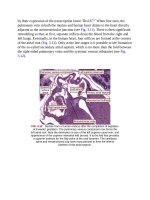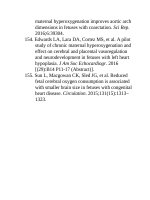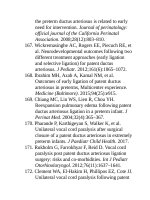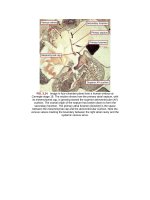Andersons pediatric cardiology 1839
Bạn đang xem bản rút gọn của tài liệu. Xem và tải ngay bản đầy đủ của tài liệu tại đây (107.66 KB, 3 trang )
NeonatalStabilization,Surgical
Strategies,andPostoperative
Management
PreoperativeManagementoftheNeonate
Thegeneralphysiologicfactorsinfluencingadequatesystemicoxygendelivery
(DO2)inneonateswitha“multidistribution”circulationarediscussedindetailin
Chapter70.Itisbeyondthescopeofthischaptertodiscusspalliativecareand
noninterventionforinfantsbornwithanyofthecomplexanomaliesinthe
spectrumofafUVH.Detaileddiscussionsoftheethicsandcontroversiesmaybe
foundelsewhere.8,25–30Inaddition,thischapterfocusesonsurgicalstrategies
leadingtowardaplannedFontanoperation.Cardiactransplantationisdiscussed
inChapter67.
Theprincipalgoalofpreoperativemanagementandstabilizationinthe
neonatewithafUVHistominimizetheriskoffuturesurgicalmanagement.This
generalprinciplecontainsanumberofkeycomponents(Box71.2).
Box71.2
KeyElementsofPreoperativeStabilization
andManagement
■Monitoringandvascularaccess
■Presentationinshock
■Effectsofpositive-pressureventilation
■Nursingconsiderationsandfamilysupport
■Feedingandnutrition
■Timingofsurgery
MonitoringandVascularAccess
Despitesignificantvariabilityinpractice,monitoringoftheneonatewitha
fUVHhassimilarfundamentalgoals.2Physiologicmonitoringgivesthebedside
cliniciananoverviewofthedynamicphysiologicstateofthepreoperative
multidistributionphysiology.Stablevascularaccessallowsforinfusionsof
prostaglandinE1(PGE1),vasoactivemedications,andparenteralnutrition.In
addition,appropriatevasculardevicesaccessprovidecrucialinformation
regardingintravascularpressures,includingsystolicanddiastolicarterialand
centralvenouspressures.Co-oximetrydatafromindwellingvascularcatheters
canprovidevaluableestimatesofcardiacoutputandmixing.Finally,continuous
tracingsfromvascularlinescanprovidecluestothephysiologicconsequences
ofimportantresidualfunctionaloranatomicabnormalities.
Therisksandbenefitsofindividualmonitoringsystemsandvascularaccess
devicesmustbecarefullyconsidered.Althoughbasicdevicessuchas
electrocardiography(ECG)andpulseoximetryposelittlerisktothepatient,
invasivedevicessuchasintravascularlinescarrytheriskofvascularinjury,
thromboemboliccomplications,bloodstreaminfection,andfuturevascular
occlusions.Devicesmustbecarefullyconsideredinthecontextofpatientacuity
andfuturevascularneeds(Table71.1).
Table71.1
CommonMonitoringforthePreoperativeNeonateWitha
FunctionallyUniventricularHeart
MonitoringDevice
Electrocardiograph
Pulseoximetry
Noninvasiveblood
pressure
Invasivearterial
catheter
Location
Rightshoulder,left
shoulder,leftleg
Righthand,lower
extremity
Rightupperextremity,
lowerextremitycalf
Umbilicalartery,
femoralartery,radial
artery
Invasivecentralvenous Umbilicalvein,
catheter
femoralvein,internal
jugularvein
Nearinfrared
Multisite
spectroscopy
iDO2index
N/A
Electroencephalography Head
Indication
All
Risks
Skinirritation
All
None
All
Irritationofthe
extremity,peripheral
nervedamage
Vascularinjury,
bleeding,infection
Needforcontinuousassessmentof
bloodpressureandfrequentarterial
bloodsampling
Centralvenouspressuremonitoring,
hyperosmolarinfusions,frequentblood
sampling
Adjunctiveassessmentofadequate
oxygendelivery
Evolving
Evaluationofepileptiformactivity
Vascularinjury,
bleeding,infection
Skinirritation
None
Skinirritation
Electrocardiography.
ContinuousECGmonitoringshouldbeusedinallpatientswithcongenitalheart
diseaseadmittedtothecardiacintensivecareunit(CICU).Astandardthreeelectrodesystemwithleadsontherightarm,leftarm,andleftleg(rightandleft
shoulderandleftabdomeninneonates)canprovideasingle-lead(leadI,II,or
III)continuousECGtracingthataccuratelydetectschangesintheheartrateand
rhythmalongwithischemicchanges.ContinuousmonitoringoftheECGtracing
canalsobeutilizedintheearlydetectionofelectrolytedisturbances,including
potassiumandcalcium.
NoninvasiveBloodPressureMonitoring.
Anocclusivecuffaroundthearmandlegofapreoperativeneonateisan
essentialnoninvasivemonitoringdevice.Inneonates,anappropriatelysizedcuff
ontheupperarmandcalfmaybeusedtomonitorarmandcalfpressures;these
shouldbeessentiallyidentical.Noninvasivebloodpressuremeasurementscanbe
madebyauscultatorymethodsorbytheuseofautomatedcuffsthatuse
oscillometricmethods.Itshouldbenotedthatoscillometricautomatedcuffs
measuresystolicandmeanarterialbloodpressuresdirectlyandcalculatethe
diastolicbloodpressure.Thusinterpretationofthediastolicbloodpressure
calculatedbytheseautomatedcuffsshouldbeinterpretedwiththisinmind,
particularlyinwithpatientswherethereisdiastolicrunoffintothepulmonary
arteryviaapatentarterialduct.
IndwellingVascularCatheters.
Oneofthemainadvantagesofanindwellingvascularcatheteristhemonitoring
ofpressureinanarterialorvenousvascularstructure.Pressuremonitoring
requirestheintroductionofanend-holecatheterintothevesseltobe
interrogated.Experttechnicalskillisnecessarytoplacethesecathetersin
preoperativeneonatestoavoidinjurytovascularstructures.Suchcathetersare
commonlyinsertedintotheumbilicalvein,femoralvein,jugularvein,umbilical
artery,femoralartery,orradialartery.Onceplaced,thecatheterisconnectedtoa
pressuretransducerviaacouplingsystemthatissubsequentlyconnectedtothe
monitor.Couplingsystemscontaintubingfilledwithasalinesolutionandaport
forzeroingthecathetertoatmosphericpressureandwithdrawingbloodsamples.
Moderntransducerscontainsiliconcrystalsthatchangeresistanceinproportion
tothechangesinpressurefromthecouplingsystem'sfluid.Thesesystemsmust
beproperlycalibratedfortheaccurateassessmentofintravascularpressures.









